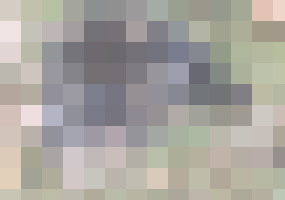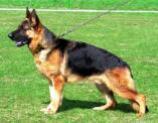
This is a placeholder text
Group text
by BlackthornGSD on 20 September 2011 - 18:09
The inside angle for the stifle in this image is 135 degrees--not 120 degrees as previously given.
Unfortunately, as has been pointed out elsewhere, these angles are more than a bit imaginary. For example, the shoulder blade and upper arm do not quite attach as indicated in this drawing. And it's important to be consistent in how the lines are drawn--through the center of the joints? How do you figure that from a photograph?


Fred Lanting talks about it here: http://www.dogstuff.info/angles_front_and_rear.html
Christine
by pod on 20 September 2011 - 20:09
Also Lanting's hind angles are evaluated with a croup angle of 35 degrees off the horizontal. The photo of Pyke shows a croup angle of ~40 degrees and he is nowhere near as extreme as the typical winning showline dog of today that has the contributing factor of crouching hindquarters to further decrease the stifle angle.
Wildmoor, this what increases the chances of joint deformity and puts extra stain and wear & tear on joints, and the reason why the showline GSD no longer lives an active life into old age. It's certainly not a return to more normal construction, as can be seen in the photo posted by myret.
Great thread smiley :)
by Ibrahim on 20 September 2011 - 20:09
Pod
Will you please re-explain this, rephrase it and state again in different words/measures/angles what increases the chances of joint deformity
I did not follow that point and I want to know what is exactly meant by that. By the way I am serious and I want to understand your point correctly please.
Ibrahim
by pod on 20 September 2011 - 22:09
There is good evidence to suggest that extreme conformation, such as that of the showline GSD, causes increased incidence of osteoarthritis. A good article here that will explain better than I ever could - http://www.meulenbrock.com.br/en/sloping.html
Also the increased strain on soft tissue, the muscles, tendons, ligament, which naturally weaken with old age, have extra strain because of the acute angles of the hindquarters, possibly the forequarters too. These angles are not inherited indiviually for each joint, they come as a package so these dogs also have increased anlges all over including the pasterns, which is one joint that seems to be particularly prone to weakening in the GSD. The concertina effect on joint angles as the soft tissue weakens with age, is one which I'm sure many GSD owners are familiar with.
by Ibrahim on 20 September 2011 - 22:09
Thanks again, Ibrahim
There are more articles to read on the site of above link.
by Abby Normal on 20 September 2011 - 22:09
Really interesting thread Smiley. I am finding the info/views regarding angles very interesting.
by Smiley on 21 September 2011 - 00:09
Link posted by SitasMom on siegers:
http://www.pedigreedatabase.com/german_shepherd_dog/siegershow_winners.html
by pod on 21 September 2011 - 11:09
http://www.gsdinfo.co.uk/General%20Info/Sloping%20topline.%20Is%20it%20detrimental.htm
CHD is prevelent in almost all breeds and must be seen as a result of breeding programmes selected to accentuate characteristics that are desirable for various breed standards."
http://www.mikeguilliard.co.uk/id14.html
I've also noticed a rather serious flaw in the drawing from Fred Lanting's site, reproduced on Blackthorn's post. The drawing of the forhand assembly shows the upper arm to be shorter than the shoulder blade, but in fact it isn't. The upper arm is ~15% longer than the shoulder blade, and this applies to all dogs, not just the GSD. This particular drawing is obviously not taken from radiograph and is probably from old text where the forehand of the dog was thought to be very similar to that of the horse, which actually does have a shorter upper arm.
The angles though, I agree with. What seems to be the holy grail of the GSD showring - the 45 degree layback and 90 degree right angle is just another take on the pursuit of the extreme, that actually has no function other than pleasing the eye of the judge. The increased braking force and all other detrimental effects of extreme angulation, and arched/roached back is contributing to orthopaedic problems of the GSD.
by Mr.GSD on 21 September 2011 - 11:09
by Mr.GSD on 21 September 2011 - 11:09
p.s. the topline has improved a little from the late `70s, but is still not back to normal, nor have sloppy hocks been fixed. These two problems have grown to be so imbedded in the genotype that there are relatively few dogs to choose from that have correct structure there, without getting even worse problems elsewhere.
Contact information Disclaimer Privacy Statement Copyright Information Terms of Service Cookie policy ↑ Back to top




